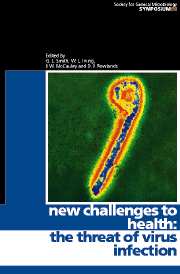Book contents
- Frontmatter
- Contents
- Contributors
- Editors' Preface
- 1 The viruses in our past, the viruses in our future
- 2 Dynamics and epidemiological impact of microparasites
- 3 The continuing threat of bunyaviruses and hantaviruses
- 4 Calicivirus, myxoma virus and the wild rabbit in Australia: a tale of three invasions
- 5 Potential of influenza A viruses to cause pandemics
- 6 The hepatitis viruses as emerging agents of infectious diseases
- 7 The emergence of human immunodeficiency viruses and AIDS
- 8 Morbilliviruses: dangers old and new
- 9 Structure–function analysis of prion protein
- 10 Endogenous retroviruses and xenotransplantation
- 11 Gammaherpesviral infections and neoplasia in immunocompromised populations
- 12 Structure and function of the proteins of Marburg and Ebola viruses
- 13 Epidemic dengue/dengue haemorrhagic fever as a public health problem in the 21st century
- 14 Borna disease virus – a threat for human mental health?
- 15 Antiviral drug development and the impact of drug resistance
- Index
8 - Morbilliviruses: dangers old and new
Published online by Cambridge University Press: 06 July 2010
- Frontmatter
- Contents
- Contributors
- Editors' Preface
- 1 The viruses in our past, the viruses in our future
- 2 Dynamics and epidemiological impact of microparasites
- 3 The continuing threat of bunyaviruses and hantaviruses
- 4 Calicivirus, myxoma virus and the wild rabbit in Australia: a tale of three invasions
- 5 Potential of influenza A viruses to cause pandemics
- 6 The hepatitis viruses as emerging agents of infectious diseases
- 7 The emergence of human immunodeficiency viruses and AIDS
- 8 Morbilliviruses: dangers old and new
- 9 Structure–function analysis of prion protein
- 10 Endogenous retroviruses and xenotransplantation
- 11 Gammaherpesviral infections and neoplasia in immunocompromised populations
- 12 Structure and function of the proteins of Marburg and Ebola viruses
- 13 Epidemic dengue/dengue haemorrhagic fever as a public health problem in the 21st century
- 14 Borna disease virus – a threat for human mental health?
- 15 Antiviral drug development and the impact of drug resistance
- Index
Summary
INTRODUCTION
The emergence, or more often the re-emergence, of disease-causing organisms is a continuing threat to mankind either directly by impacting on human health, or indirectly through the effects they may have on wild and domesticated animals. Virus infections can cause disease outbreaks of plague dimensions in humans and animals, with serious social, economic and environmental consequences. In the past, diseases such as smallpox, measles, polio and influenza have caused devastation in the human population. Smallpox has the distinction of being the only virus disease to have been eradicated globally while the others mentioned above are, or can be, effectively controlled by vaccination.
Almost every year, new viruses emerge which threaten the lives of humans and animals. In particular, members of the family Paramyxoviridae, a group that includes viruses causing some of the most virulent diseases of animals, pose significant medical, economic and ecological threats (Chant et al., 1998; Renshaw et al., 2000). Of the many new paramyxoviruses that have emerged in the past decade, the so-called ‘equine morbillivirus’ received a high profile in the mid-1990s because it caused the deaths of several racehorses and two human fatalities in Australia (Murray et al., 1995). The virus was initially grouped with the morbilliviruses because of a distant sequence relationship with members of the group, but it is now considered to belong to a new, as yet unnamed, genus in the Paramyxoviridae. It has been renamed Hendra virus, after the location of the first outbreak. In 1999, another newly discovered paramyxovirus, Nipah virus, caused a calamitous outbreak of disease in pigs in Malaysia.
- Type
- Chapter
- Information
- New Challenges to HealthThe Threat of Virus Infection, pp. 155 - 178Publisher: Cambridge University PressPrint publication year: 2001
- 5
- Cited by



